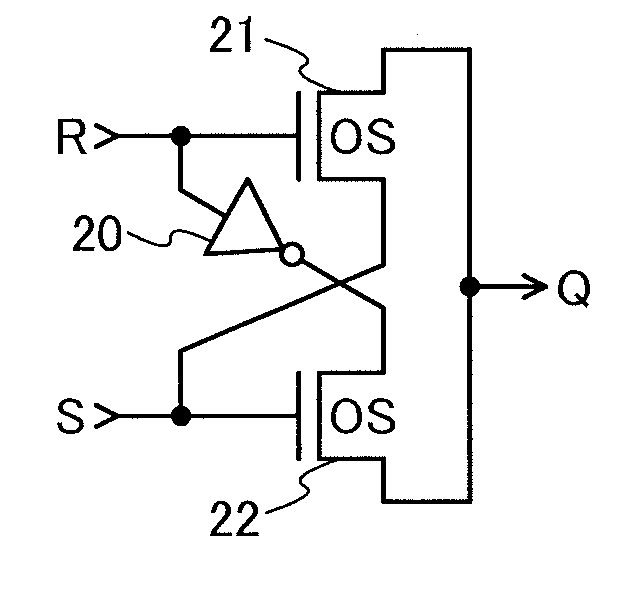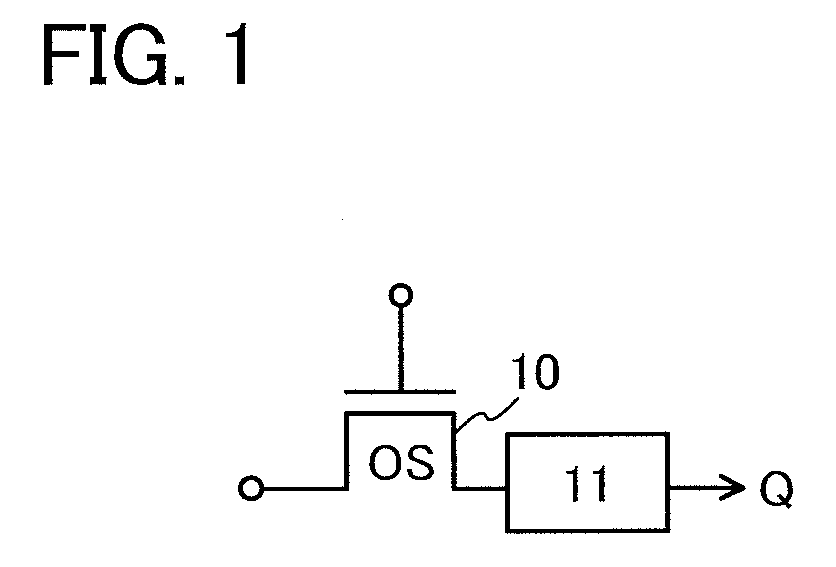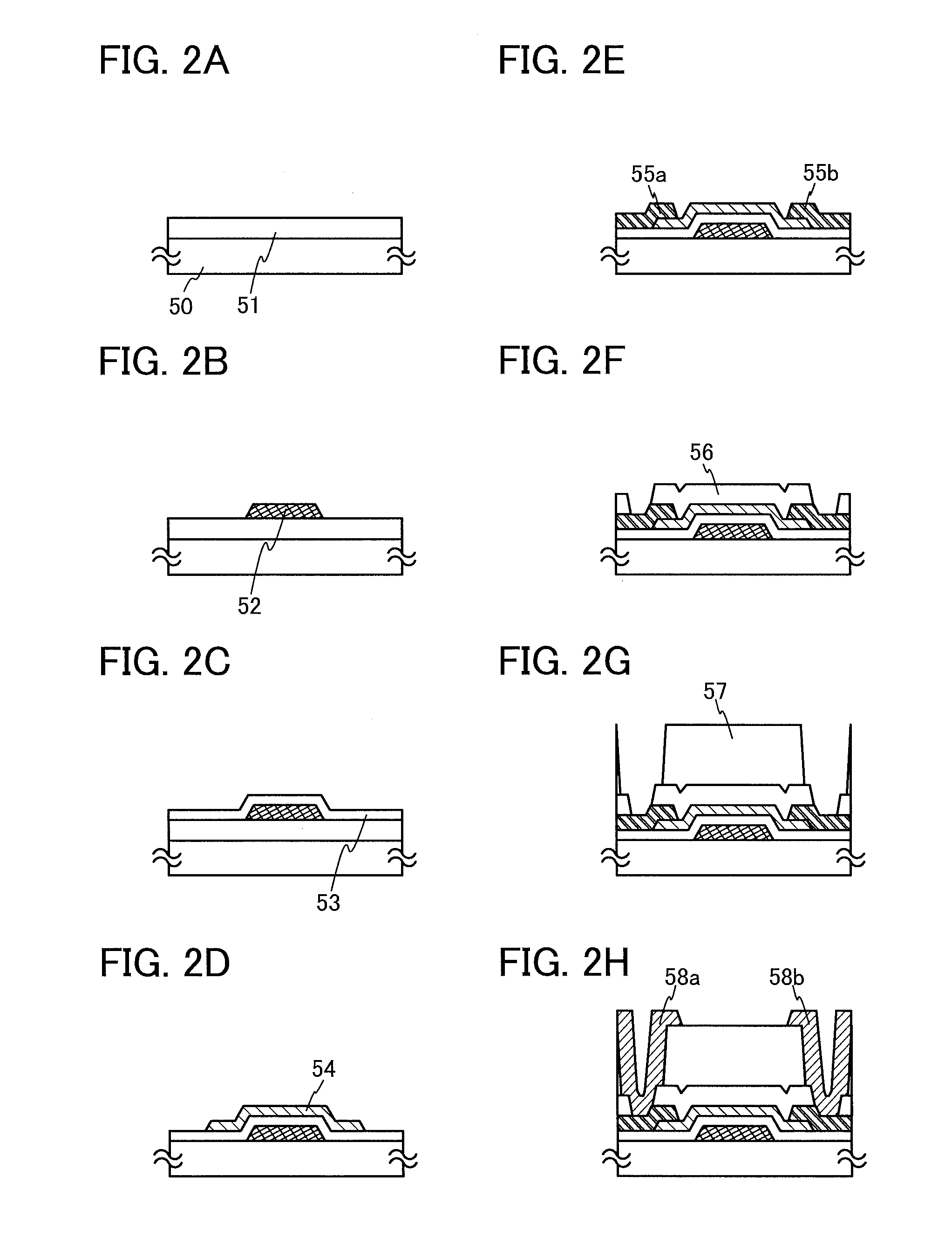Semiconductor device including latch circuit
a latch circuit and semiconductor technology, applied in logic circuits, logic functions, pulse techniques, etc., can solve the problems of data retention deterioration due to the increase in the number of rewrite operations, and achieve the effect of suppressing data retention deterioration and reducing the number of transistors
- Summary
- Abstract
- Description
- Claims
- Application Information
AI Technical Summary
Benefits of technology
Problems solved by technology
Method used
Image
Examples
specific example
[0124]Specific examples of the latch circuit will be described with reference to FIGS. 9A and 9B, FIG. 10, FIGS. 11A and 11B, FIGS. 12A and 12B, FIGS. 13A and 13B, FIGS. 14A and 14B, FIGS. 15A and 15B, FIGS. 16A and 16B, FIGS. 17A and 17B, FIGS. 18A and 18B, FIGS. 19A and 19B, FIGS. 20A and 20B, FIGS. 21A and 21B, FIGS. 22A and 22B, FIGS. 23A and 23B, FIGS. 24A and 24B, and FIGS. 25A and 25B.
First Specific Example of SR Latch Circuit
[0125]FIG. 9A is a circuit diagram illustrating a specific example of an SR latch circuit. The SR latch circuit in FIG. 9A includes an inverter 20, a transistor 21, and a transistor 22. An input terminal of the inverter 20 is electrically connected to a reset terminal (a first input terminal of the SR latch circuit in FIG. 9A, hereinafter also referred to as a terminal R). A gate of the transistor 21 is electrically connected to the terminal R. One of a source and a drain of the transistor 21 is electrically connected to a set terminal (a second input te...
first specific example
of Gated SR Latch Circuit
[0154]FIG. 20A is a circuit diagram illustrating a specific example of a gated SR latch circuit. The gated SR latch circuit in FIG. 20A includes a NAND gate 80, a NAND gate 81, an inverter 82, an inverter 83, a transistor 84, and a transistor 85. A first input terminal of the NAND gate 80 is electrically connected to a terminal E (a first input terminal of the gated SR latch circuit in FIG. 20A). A second input terminal of the NAND gate 80 is electrically connected to a terminal R (a second input terminal of the gated SR latch circuit in FIG. 20A). A first input terminal of the NAND gate 81 is electrically connected to the terminal E. A second input terminal of the NAND gate 81 is electrically connected to a terminal S (a third input terminal of the gated SR latch circuit in FIG. 20A). An input terminal of the inverter 82 is electrically connected to an output terminal of the NAND gate 80. An input terminal of the inverter 83 is electrically connected to an ...
second specific example
of Gated SR Latch Circuit
[0160]FIG. 22A is a circuit diagram illustrating a specific example of a gated SR latch circuit. The gated SR latch circuit in FIG. 22A includes a NAND gate 90, a NAND gate 91, a NAND gate 92, and a transistor 93. A first input terminal of the NAND gate 90 is electrically connected to a terminal E (a first input terminal of the gated SR latch circuit in FIG. 22A). A second input terminal of the NAND gate 90 is electrically connected to a terminal S (a second input terminal of the gated SR latch circuit in FIG. 22A). A first input terminal of the NAND gate 91 is electrically connected to the terminal E. A second input terminal of the NAND gate 91 is electrically connected to a terminal R (a third input terminal of the gated SR latch circuit in FIG. 22A). A first input terminal of the NAND gate 92 is electrically connected to an output terminal of the NAND gate 90. A second input terminal of the NAND gate 92 is electrically connected to an output terminal of t...
PUM
 Login to View More
Login to View More Abstract
Description
Claims
Application Information
 Login to View More
Login to View More - R&D
- Intellectual Property
- Life Sciences
- Materials
- Tech Scout
- Unparalleled Data Quality
- Higher Quality Content
- 60% Fewer Hallucinations
Browse by: Latest US Patents, China's latest patents, Technical Efficacy Thesaurus, Application Domain, Technology Topic, Popular Technical Reports.
© 2025 PatSnap. All rights reserved.Legal|Privacy policy|Modern Slavery Act Transparency Statement|Sitemap|About US| Contact US: help@patsnap.com



